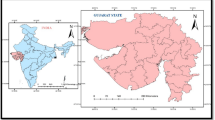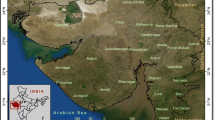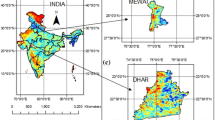Abstract
Drought is a natural hazard which occurs in all climatic zones. The effect from drought can cause a serious problem for agricultural activities, economies and the environment. There is a need to characterize drought events in terms of drought severity, frequency and possibility of drought occurrence for better drought management. An examination of drought characteristics and drought severity using the Standardized Precipitation Index (SPI) and the Vegetation Condition Index (VCI) was carried out for different land cover types. The study examined how data mining techniques such as association rules could be used to elucidate the relationships between VCI and SPI in order to predict the possibility of drought occurrence. Rainfall datasets were collected from the Thai meteorological department for the period 1980–2009 and digitally encoded into a Geographic Information System database. SPI values were derived both temporally and spatially for quantitative measurement of drought events over the 30-year period. Monthly VCI values were calculated from NDVI data collected from year 2001 to 2009 using multi-temporal Terra MODIS Vegetation Indices Product (MOD13Q1). Data mining technique was introduced and applied to generate association rules between VCI and SPI to predict the possibility of drought occurrence. The results from multi-temporal SPI analysis shown drought event occurred more often for the 3- and 6-month SPI in October at the central and the northeastern part of the region. Spatial SPI revealed that high-drought-risk areas were in the southwest and extending to the central part of the region. The statistically significant correlations between monthly VCI and SPI at the multiple timescales were found for mixed deciduous forest in dry period. This result indicated vegetation condition for this forest type was sensitive for precipitation during dry period. Drought events were found to affect the rice crop in the central part of the region more, as observed from the negative correlation between VCI and SPI during growing season. The representative association rules from VCI and SPI revealed drought event also occurred for paddy field in the central part of the region. Drought periods within the growing season for this area are becoming more prevalent even with increase in annual rainfall. Shorter scale of SPI was found to be effective in characterizing drought conditions. This study combined the different level of software and dataset used which are able to predict future occurrence and severity of drought using the current condition. Results can be applied to assess drought severity and drought-affected areas for efficient drought management and planning.











Similar content being viewed by others
References
Abarghouei HB, Zarch MAA, Dastorani MT, Kousari MR, Zarch MS (2011) The survey of climatic drought trend in Iran. Stoch Environ Res Risk Assess 25:851–863
Azevedo PJ, Jorge AM (2007) Comparing rule measures for predictive association rules. In: Kok JN, Koronacki J, de Mantaras RL, Matwin S, Mladenič D, Skowron A (eds) Machine learning: ECML 2007. Lecture notes in computer science. Springer, Berlin Heidelberg, pp 510–517
Basistha A, Arya DS, Goel NK (2008) Spatial distribution of rainfall in Indian Himalayas—a case study of Uttarakhand Region. Water Resour Manag 22:1325–1346
Bayarjargal Y, Karnieli A, Bayasgalan M, Khudulmur S, Gandush C, Tucker CJ (2006) A comparative study of NOAA–AVHRR derived drought indices using change vector analysis. Remote Sens Environ 105:9–22
Bhuiyan C, Singh RP, Kogan FN (2006) Monitoring drought dynamics in the Aravalli region (India) using different indices based on ground and remote sensing data. Int J Appl Earth Obs Geoinf 8:289–302
Brown JF, Wardlow BD, Tadesse T, Hayes MJ, Reed BC (2008) The Vegetation Drought Response Index (VegDRI): a new integrated approach for monitoring drought stress in vegetation. GISci Remote Sens 45(1):16–46
Burrough PA (2001) GIS and geostatistics: essential partners for spatial analysis. Environ Ecol Stat 8:361–377
Dhakar R, Sehgal VK, Pradhan S (2013) Study on inter-seasonal and intra-seasonal relationships of meteorological and agricultural drought indices in the Rajasthan State of India. J Arid Environ 97:108–119
Dhanya CT, Nagesh Kumar D (2009) Data mining for evolution of association rules for droughts and floods in India using climate inputs. J Geophys Res Atmos. doi:10.1029/2008JD010485
Garrote L, Martin-Carrasco F, Flores-Montoya F, Iglesias A (2007) Linking drought indicators to policy actions in the Tagus Basin drought Management Plan. Water Resour Manag 21:873–882
Gibert K, Spate J, Sànchez-Marrè M, Athanasiadis IN, Comas J (2008) Chapter twelve data mining for environmental systems. In: Jakeman AJ (ed) AAV developments in integrated environmental assessment, environmental modelling, software and decision support. Elsevier, New York, pp 205–228
Giddings L, Soto M, Rutherford BM, Maarouf A (2005) Standardized precipitation index zones for México. Atmosfera 18:33–56
Glenn EP, Huete AR, Nagler PL, Nelson SG (2008) Relationship between remotely-sensed vegetation indices, canopy attributes and plant physiological processes: What vegetation indices can and cannot tell us about the landscape. Sensors 8:2136–2160
Gu Y, Brown JF, Verdin JP, Wardlow B (2007) A five-year analysis of MODIS NDVI and NDWI for grassland drought assessment over the central Great Plains of the United States. Geophys Res Lett 34
Hahsler M, Buchta C, Hornik K (2008) Selective association rule generation. Comput Stat 23:303–315
Harms SK, Deogun JS (2004) Sequential association rule mining with time lags. J Intell Inf Syst 22:7–22
Huete A, Didan K, Miura T, Rodriguez EP, Gao X, Ferreira LG (2002) Overview of the radiometric and biophysical performance of the MODIS vegetation indices. Remote Sens Environ 83(1–2):195–213
Jain SK, Keshri R, Goswami A, Sarkar A (2010) Application of meteorological and vegetation indices for evaluation of drought impact: a case study for Rajasthan, India. Nat Hazards 54:643–656
Johnston K, Jay M, Hoef V, Krivoruchko K, Lucas N (2001) Using ArcGIS geostatistical analyst, ESRI
Karavitis CA, Alexandris S, Tsesmelis DE, Athanasopoulos G (2011) Application of the Standardized Precipitation Index (SPI) in Greece. Water 3:787–805
Karnieli A, Agam N, Pinker RT, Anderson M, Imhoff ML, Gutman GG, Panov N, Goldberg A (2010) Use of NDVI and land surface temperature for drought assessment: merits and limitations. J Clim 23:618–633
Khan S, Gabriel HF, Rana T (2008) Standardized Precipitation Index to track drought and assess impact of rainfall on watertables in irrigation areas. Irrig Drain Syst 22:159–177
Kogan FN (1995) Application of vegetation index and brightness temperature for drought detection. Adv Space Res 15:91–100
Kumar MN, Muthy CS, Sai MVRS, Roy PS (2009) On the use of the Standardized Precipitation Index (SPI) for drought intensity assessment. Meteorol Appl 16:381–389
Lai X, Li G, Gan Y, Ye Z (2006) An association rule mining approach for satellite cloud images and rainfall. In: Zhuang Y, Yang S-Q, Rui Y, He Q (eds) Advances in multimedia information processing—PCM 2006. Lecture notes in computer science. Springer, Berlin, pp 658–666
Li B, Su H, Chen F, Wu J, Qi J (2013) The changing characteristics of drought in China from 1982 to 2005. Nat Hazards 68:723–743
Lloyd-Hughes B, Saunders MA (2002) A drought climatology for Europe. Int J Climatol. doi:10.1002/joc.846
Mckee BT, Doesken JN, Kleist J (1993) The relationship of drought frequency and duration to time scales. In: Proceeding of the eight conference on applied climatology, 17–22 January, Anaheim, CA
Mongkolsawat C (2006) Northeast Thailand: Spatial potentials for development. Khon Kaen Karn. Pim Press, Khon Kaen
Pandey S, Pandey AC, Nathawat MS, Kumar M, Mahanti NC (2012) Drought hazard assessment using geoinformatics over parts of Chotanagpur plateau region, Jharkhand, India. Nat Hazards 63:279–303
Paulo AA, Pereira LS (2008) Stochastic Prediction of drought class transitions. Water Resour Manag 22:1277–1296
Prasad VK, Anuradha E, Badarinath KVS (2005) Climatic controls of vegetation vigor in four contrasting forest types of India—evaluation from National Oceanic and Atmospheric Administration’s advanced very high resolution radiometer datasets (1990–2000). Int J Biometeorol 50:6–16
Rouault M, Richard Y (2003) Intensity and spatial extension of drought in South Africa at different time scales. Water SA 29:489–500
Şahin M (2012) Modelling of air temperature using remote sensing and artificial neural network in Turkey. Adv Space Res 50(7):973–985
Sharma A (2006) Spatial data mining for drought monitoring: an approach using temporal NDVI and rainfall relationship. Master thesis, The International Institute for Geo-information Science and Earth Observation
Shekhar A, Chawla S (2003) Spatial database: a tour. Pearson Education Inc., Upper Saddle River
Sönmez FK, Kömüscü AÜ, Erkan A, Turgu E (2005) An analysis of spatial and temporal dimension of drought vulnerability in Turkey using the Standardized Precipitation Index. Nat Hazards 35:243–264
Tadesse T, Wlhite DA, Hayes MJ, Harms SK, Goddard S (2004) Drought Monitoring using data mining techniques: a case study for Nebraska, USA. Nat Hazards 33(1):137–159
Tadesse T, Wlhite DA, Hayes MJ, Harms SK, Goddard S (2005) Discovering Associations between climatic and oceanic parameters to monitor drought in Nebraska using data-mining techniques. J Clim 18:1541–1550
Taghi Sattari M, Anli AS, Apaydin H, Kodal S (2011) Decision trees to determine the possible drought periods in Ankara. Atmosfera 25
Thai Royal forest Department (2010) Forest statistical data. http://forestinfo.forest.go.th/55/. Accessed 21 November 2012
The Department of Disaster prevention and Mitigation, Thailand (2012) Drought statistic of Thailand since 1989–2010. http://61.19.100.58/public/group4/disaster01/data20y/drought20y_1.pdf. Accessed 11 October 2012
Vicente-Serrano SM (2006) Evaluating the impact of drought using remote sensing in a Mediterranean, semi-arid region. Nat Hazards 40:173–208
Volcani A, Karnieli A, Svoray T (2005) The use of remote sensing and GIS for spatio-temporal analysis of the physiological state of a semi-arid forest with respect to drought years. For Ecol Manag 215:239–250
Wilhite DA, Svoboda MD, Hayes MJ (2007) Understanding the complex impacts of drought: a key to enhancing drought mitigation and preparedness. Water Resour Manag 21:763–774
Zeng B, Yang TB (2008) Impacts of climate warming on vegetation in Qaidam area from 1990 to 2003. Environ Monit Assess 144:403–417
Zhang Q, Xu C, Zhang Z (2008). Observed change of drought/wetness episodes in the Perl River basin, China using the standardized precipitation index and aridity index. Theor Appl Climatol. doi:10.1007/s007
Zhou L, Wu J, Zhang J, Zhao F, Liu M, Zhao L (2010) Assessing the drought monitoring characteristic of time series NDVI indices in crop growing season. Presented at the Geoscience and Remote Sensing Symposium (IGARSS), 2010 IEEE International, pp 2063–2066
Acknowledgments
This work was supported by the Higher Education Research Promotion and National Research University Project of Thailand, Office of the Higher Education Commission, Thailand.
Author information
Authors and Affiliations
Corresponding author
Rights and permissions
About this article
Cite this article
Thavorntam, W., Tantemsapya, N. & Armstrong, L. A combination of meteorological and satellite-based drought indices in a better drought assessment and forecasting in Northeast Thailand. Nat Hazards 77, 1453–1474 (2015). https://doi.org/10.1007/s11069-014-1501-0
Received:
Accepted:
Published:
Issue Date:
DOI: https://doi.org/10.1007/s11069-014-1501-0




